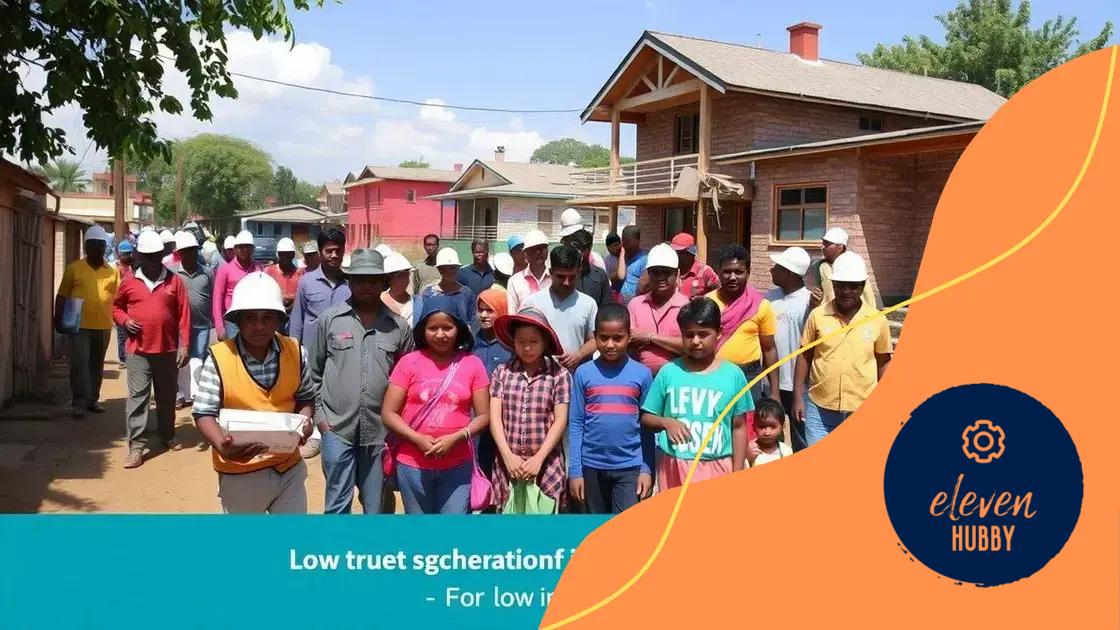Federal funding for low-income housing development is essential

Federal funding for low-income housing development plays a crucial role in providing affordable housing, improving living conditions, and fostering community growth through various programs and initiatives.
Federal funding for low-income housing development is crucial in addressing the housing crisis many communities face today. Have you ever wondered how these funds transform neighborhoods and create opportunities for families? Let’s explore this significant topic.
The importance of federal funding for housing
The importance of federal funding for housing cannot be overstated. This financial support plays a key role in ensuring that low-income families have access to safe and affordable homes. Federal funds are essential for the construction and preservation of housing units that cater to those in need.
How federal funding impacts communities
When federal funding is allocated, it generates numerous benefits for local communities. It not only promotes the construction of new homes but also revitalizes existing neighborhoods. Communities thrive when people have stable housing.
- Reduces homelessness and housing insecurity.
- Encourages economic growth by creating jobs.
- Supports local businesses through increased spending.
The positive effect of federal funding for housing can be seen in various programs. For instance, initiatives like the Low-Income Housing Tax Credit (LIHTC) help leverage private investments to finance affordable housing projects. Such policies drive innovation in housing development.
Challenges and solutions
Even though federal funding is crucial, there are challenges associated with accessing it. Bureaucratic hurdles can delay the implementation of housing projects, leaving families waiting for needed assistance. Streamlining processes and improving communication between organizations can enhance the efficiency of fund allocation.
Moreover, some communities face resistance when new housing projects are proposed. Addressing concerns through community engagement and education can help mitigate this opposition. By involving residents in planning discussions, communities can create a shared vision for housing that meets everyone’s needs.
Overall, federal funding for housing is a vital investment in the future of our communities. By supporting affordable housing initiatives, we can foster inclusive neighborhoods where everyone has the opportunity to thrive.
How federal funding supports low-income communities
Federal funding significantly supports low-income communities by providing resources necessary for vital housing projects. These funds help ensure that families have access to <>safe and affordable housing solutions, which is crucial for stability and success in life.
Direct benefits of federal funding
One primary way that federal funding aids communities is through the development of low-income housing. By financing new constructions or renovating existing ones, it helps keep living costs manageable.
- Increases the availability of affordable housing.
- Improves living conditions with quality structures.
- Stimulates local economies through job creation.
Moreover, these funds often target health and social services. This ensures that residents receive necessary support, contributing to overall community well-being. For example, funding helps develop community centers that provide resources for education and social services.
Community engagement and empowerment
An essential aspect of federal funding is its ability to empower communities. When residents are involved in the planning process, they are more likely to advocate for their needs. This leads to better outcomes and sustained success in community initiatives.
Engaging locals can help build strong relationships among residents and organizations. This collective effort fosters a sense of ownership and responsibility, leading to projects that truly reflect the community’s desires and needs. In this way, federal funding becomes a tool for positive change.
Ultimately, federal funding for low-income communities is not just about providing financial aid; it’s about creating opportunities for growth, stability, and lasting success for families.
Key programs for housing development

Understanding the key programs for housing development is essential for anyone interested in improving low-income housing accessibility. These programs provide the framework and funding needed to build, rehabilitate, and maintain affordable housing across various communities.
Major federal programs
Several federal programs specifically target low-income housing development. These initiatives aim to close the gap in affordable housing availability and create sustainable communities.
- The Low-Income Housing Tax Credit (LIHTC) encourages private investment by providing tax incentives for the development of affordable housing.
- The HOME Investment Partnerships Program offers grants to states and localities to create affordable housing for low-income individuals and families.
- The Community Development Block Grant (CDBG) program supports community development initiatives, including affordable housing.
These programs not only provide funding but also establish guidelines to ensure that housing is affordable and accessible. For instance, LIHTC properties must remain affordable for a specified period, ensuring that low-income families benefit long-term.
State and local initiatives
In addition to federal support, state and local programs play a crucial role in housing development. Many cities have their own housing trust funds that provide resources for affordable housing projects. These local initiatives often address specific community needs and goals.
Furthermore, partnerships between public and private sectors are essential. By collaborating with nonprofit organizations, local developers can create innovative solutions that leverage multiple funding sources. This approach maximizes resources, ensuring that the projects meet the unique needs of each community.
Overall, a combination of federal, state, and local programs helps to create a robust framework for housing development, making it possible to provide safe, affordable homes for those in need.
Challenges in accessing federal funding
Accessing federal funding for housing development often comes with various challenges. These issues can create barriers for communities seeking the financial support necessary to improve low-income housing.
Complex application processes
One major challenge is the complex application processes that many organizations face. The requirements for different funding programs can vary significantly, making it difficult for applicants to navigate the system effectively. This complexity can lead to delays or even deter some from applying.
- Detailed documentation is often required.
- Understanding eligibility criteria can be difficult.
- Technical assistance may be necessary, which can extend timelines.
Many organizations lack the resources to hire staff who are experienced in grant writing and management, further complicating their ability to access funds.
Competition for limited resources
Another challenge is the fierce competition for limited resources. As demand for affordable housing continues to rise, more organizations are vying for the same pool of federal funds. This makes securing funding increasingly difficult.
Applicants must demonstrate their capacity to effectively manage projects and deliver results. Consequently, smaller organizations may struggle to compete with larger, well-established entities that have more experience and a proven track record. This can lead to challenges in achieving equitable access to funding.
Moreover, changing political climates and budget cuts can also affect the availability of funds. Organizations must stay informed about legislation and funding priorities to adapt their strategies, which requires additional effort and resources.
Despite these challenges, understanding the funding landscape and developing strong relationships with local and federal agencies can help mitigate some of these barriers. Collaboration and community engagement are key to overcoming these obstacles and ensuring that low-income communities receive the support they need.
Future trends in housing funding
Looking into the future, several trends are likely to shape housing funding. These trends aim to improve access to affordable housing and ensure sustainable development for all communities.
Increased focus on sustainability
One significant trend is the increased focus on sustainability in housing development. As communities strive to meet rigorous environmental standards, funding will shift towards projects that incorporate green building practices. This means more energy-efficient homes that reduce utility costs for families.
- Incorporating renewable energy sources in new buildings.
- Utilizing sustainable materials for construction.
- Focusing on water conservation and waste reduction.
Developers are also encouraged to create homes that are environmentally friendly and economically viable long-term, which will be critical as climate concerns grow.
Technology and innovation
Another promising trend is the use of technology and innovation in housing development. Funders are beginning to embrace technological solutions to improve project delivery and manage costs efficiently. For instance, digital platforms can simplify the application process for federal funding, making it easier for organizations to secure necessary resources.
Additionally, smart home technologies that enhance safety and efficiency are gaining popularity. These advancements can attract more investment in affordable housing projects, which could amplify the availability of funding.
Community-driven funding models
Future trends also indicate a rise in community-driven funding models. This involves empowering residents to have a say in housing decisions that impact their lives. By prioritizing local needs, funding can be better allocated to initiatives that genuinely reflect community priorities.
Collaborative models, where public-private partnerships work together with community organizations, are likely to become more common. This approach ensures that resources are used wisely and that funding initiatives cater to varied needs.
Overall, the future of housing funding appears to be moving towards more innovative, sustainable, and community-focused strategies that address the pressing need for affordable housing for everyone.
FAQ – Frequently Asked Questions about Federal Funding for Low-Income Housing Development
What are the main sources of federal funding for housing?
Main sources include the Low-Income Housing Tax Credit (LIHTC), the HOME Investment Partnerships Program, and the Community Development Block Grant (CDBG) program.
How does federal funding help low-income communities?
Federal funding supports low-income communities by financing affordable housing projects, which helps increase availability and improve living conditions.
What are some challenges in accessing federal funding?
Challenges include complex application processes, competition for limited resources, and changing political climates affecting funding availability.
What future trends are expected in housing funding?
Future trends include greater sustainability focus, increased technology integration, and community-driven funding models that empower local decision-making.






